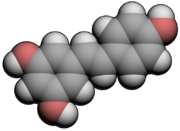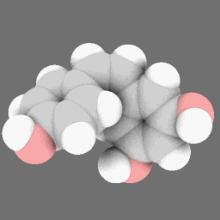Summary: A new study reports reveratrol could be a therapeutic candidate for the management and treatment of Alzheimer’s disease.
Source: Bentham Science Publishers.
Resveratrol is a naturally occurring polyphenolic phytochemical produced in several plants, especially grapes skin and seeds. One epidemiological study reported a positive association between moderate red wine consumption and a low incidence of cardiovascular disease, known as the “French Paradox.”
The neuroprotective effects of resveratrol for the treatment of Alzheimer’s disease (AD) have been investigated in various in vitro and in vivo models of AD. Despite the high bioactivity of resveratrol in AD, there is poor bioavailability of resveratrol, that is, the concentrations required producing favourable biological effects in the brain and neuronal cells are insufficient to demonstrate efficacy in humans. Therefore, successful clinical application of resveratrol as a single ‘take home’ oral therapy alone presents a major challenge for the treatment of AD.
We propose herein a novel combination therapy consisting of an agent for chelating redox-active metals (Fe2+) and/or an antioxidant to reduce damage caused by residual oxygen free radicals, in addition to resveratrol, a modulator of AMPK and sirtuin pathways (nuclear transcription).
The addition of resveratrol may have the capacity to increase activity of the NAD+- dependant deacetylases such as sirtuin family enzymes (e.g. SIRT1) and promote improved DNA repair by enhancing PARP enzyme activity through increased production of their essential substrate NAD+, and thus improve cell viability and longevity.
A synergistic combination of a selected antioxidant substances, Fe2+ chelating agents and resveratrol may be expected to provide a more clinically successful treatment.
ABOUT THIS NEUROSCIENCE RESEARCH ARTICLE
Source: Bentham Science Publishers
Image Source: This NeuroscienceNews.com image is credited to Dr. Nady Braidy et al, Bentham Science Publishers.
Original Research: Abstract for “Resveratrol as a Potential Therapeutic Candidate for the Treatment and Management of Alzheimer’s Disease” by Nady Braidy, Bat-Erdene Jugder, Anne Poljak, Tharusha Jayasena, Hussein Mansour, Seyed Mohammad Nabavi, Perminder Sachdev and Ross Grant inCurrent Topics in Medicinal Chemistry. Published online June 2016doi:10.2174/1568026616666160204121431
Image Source: This NeuroscienceNews.com image is credited to Dr. Nady Braidy et al, Bentham Science Publishers.
Original Research: Abstract for “Resveratrol as a Potential Therapeutic Candidate for the Treatment and Management of Alzheimer’s Disease” by Nady Braidy, Bat-Erdene Jugder, Anne Poljak, Tharusha Jayasena, Hussein Mansour, Seyed Mohammad Nabavi, Perminder Sachdev and Ross Grant inCurrent Topics in Medicinal Chemistry. Published online June 2016doi:10.2174/1568026616666160204121431
| Resveratrol Alerta sobre risco à saúde | |
|---|---|
 | |
 | |
| Outros nomes | trans-3,5,4'-Trihydroxystilbene; 3,4',5-Stilbenetriol; trans-Resveratrol; (E)-5-(p-Hydroxystyryl)resorcinol (E)-5-(4-hydroxystyryl)benzene-1,3-diol |
| Identificadores | |
| Número CAS | |
| PubChem | |
| ChemSpider | |
| SMILES | |
| InChI | 1/C14H12O3/c15- 12-5-3-10(4-6-12) 1-2-11-7-13(16)9- 14(17)8-11/h1-9,15- 17H/b2-1+ |
| Propriedades | |
| Fórmula química | C14H12O3 |
| Massa molar | 228.23 g mol-1 |
| Aparência | white powder with slight yellow cast |
| Solubilidadeem water | 0.03 g/L |
| Solubilidadeem DMSO | 16 g/L |
| Solubilidadeem ethanol | 50 g/L |
| Exceto onde denotado, os dados referem-se a materiais sob condições normais de temperatura e pressão Referências e avisos gerais sobre esta caixa. Alerta sobre risco à saúde. | |

No comments:
Post a Comment